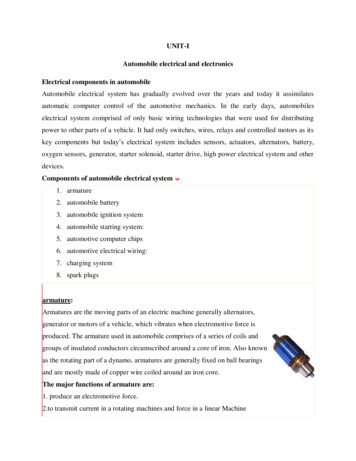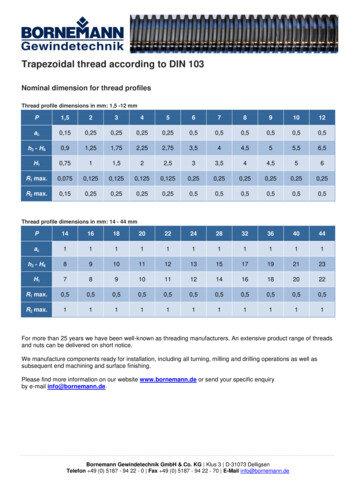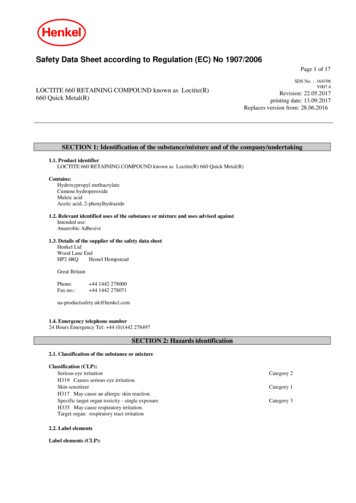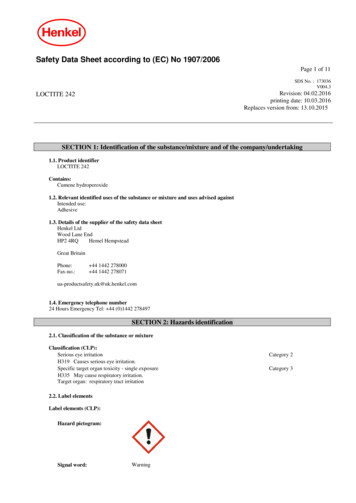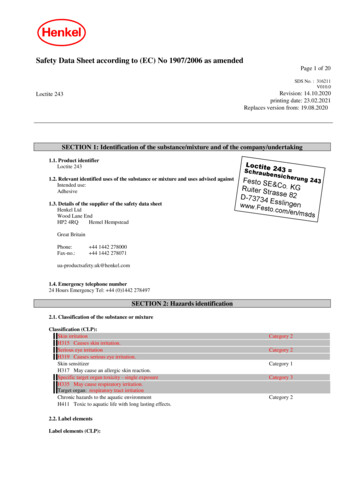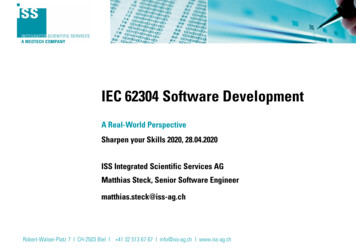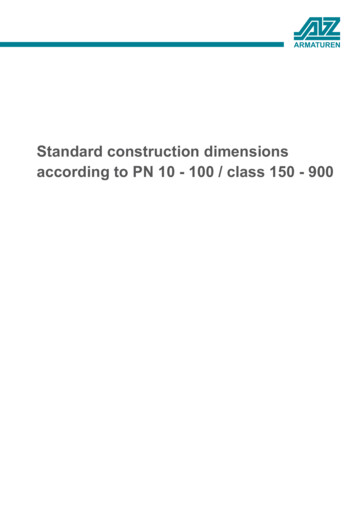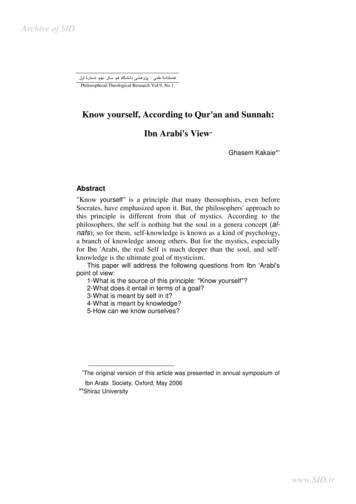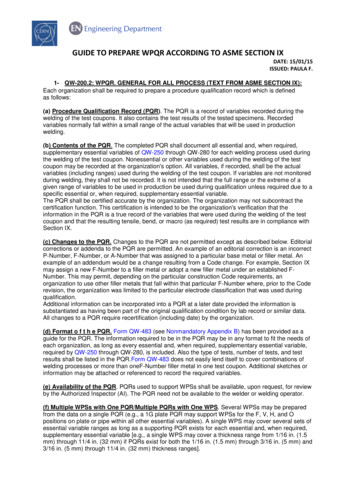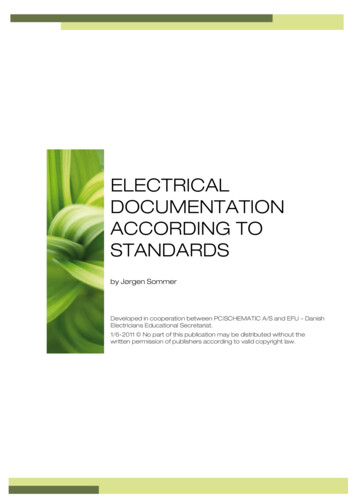
Transcription
ELECTRICALDOCUMENTATIONACCORDING TOSTANDARDSby Jørgen SommerDeveloped in cooperation between PC SCHEMATIC A/S and EFU – DanishElectricians Educational Secretariat.1/6-2011 No part of this publication may be distributed without thewritten permission of publishers according to valid copyright law.
Introduction and contentsPublished by PC SCHEMATIC A/S3rd edition 2011Copyright 2003-2011, PC SCHEMATIC A/SNo part of this publication may be distributed withoutthe written permission of publishers according to validcopyright law.Electical documentation according to standards1st edition 20032nd edition 2006, reprinted and corrected 2008.3rd edition 2011Illustrations are made withPC SCHEMATIC AutomationISBN 978 87 989072 4 4EAN 9788798907244Electrical documentation according to standardspage 2
Introduction and contentsElectrical documentation according to standardspage 3
Introduction and contentsIntroductionReliability comes first!The present publication is written for machine producers; electrical controlpanels assemblers and other technical personnel who have to preparetechnical documentation. The book does not always prescribe what one shoulddo in a certain situation, but provides examples and instructions that can beused as a basis for compiling technical documentation. The 2nd edition containsmore useful samples and directions. The standard users must decide forthemselves which version is the most appropriate on the basis of rules,references, suggestions and requirements. If you still have any doubts, pleaseask for help from the National Standard Association or any other expert. But thefinal decision is yours and according to the Machinery Directive (Directive98/37/EC) you are responsible for the final solution.Who is the publisher of this book?The current edition was published by DpS CAD-centre ApS at the request ofand in cooperation with EFU – The Danish Electricians Educational Secretariat(today EVU - the Danish Electricians and Plumbers Educational Secretariat) inDenmark. The book is written by Jørgen Sommer, an employee of DpS whoseresponsibilities include selling and marketing of PCschematic CAD-programsintended for preparing electrical documentation. According to an agreementwith Dansk Standard (Danish Standards (the Danish national standardsassociation)), the publishers have rights to use and distribute the drawings andtexts from various standards.The book is compiled in cooperation with the following experts: Per Holmstrøm,consultant of electro techniques and, among other things, an expert on theMachinery Directive; Karl-Anker Thorn, the project leader in the standardizationcommission S-503 (documentation standards) from Danish Standards;Flemming Larsen from ELFO-TEKNIQ, and Leif Steffensen from the NationalWork Environment Authority (Arbejdstilsynet). In addition, the author hasconsulted several companies and technical schools.Thanks to everyone who has contributed to compiling this piece of writing.Introduction to 3rd editionYou are holding the 3rd edition of the book, which has been updated with thelatest editions of the standards. Jørgen Sommer is once again active as author,even though he has retired. Once again, we invite you to send in anysuggestions, ideas and corrections that could be taken into considerations inthe next editions. You can use this email: book@pcschematic.com.Jyllinge, June 2011Electrical documentation according to standardspage 4
Introduction and contentsElectrical documentation according to standardspage 5
Introduction and contentsContentsIntroduction4Briefly about the book11Directives15Machinery DirectiveNational regulationsLow Voltage DirectiveEMC Directive15161718Responsibility21Is the electrician “the manufacturer” when changing the machineEuropean requirementsGeneral information about standardsWhat does the present publication coverElectrical documentation and documentation in generalElectrical documentation with or without a CAD-programHow you can work with standardsUse the references to other standardsYour guarantee when choosing a CAD-programTechnical documentationGeneral requirements to electrical documentationThree standards of essential importanceWhat should technical documentation include?Common requirements for the complete documentationTechnical dossierInformation sheetSome examples of explanationsTypes of diagramsEquivalent circuit diagramConnection diagramCircuit diagramsExamples of documentationCombined circuit and connection diagramsInner connection diagrams and tablesOuter connection diagrams and tablesTerminal connection diagrams and tablesCable diagrams, tables, and listsLocation and installation documentsInstallation drawings and diagramsGeneral information about diagrams and 960616162636363Parts, components and spare parts lists69Technical drawing73Drawing formatsDrawing header and title blockReference gridConductorsLines and line thicknessesConnecting linesSymbolsGraphical representation and overview of symbolsNon-standardized symbolsSymbol size and shape73737474747583838686Electrical documentation according to standardspage 6
Introduction and contentsSymbols and operating stateDesign of symbolsComposite symbolsCorrect use of symbolsMarking and identificationFunction markingMarking of control equipmentReference designationIdentification of conductorInformation about conductorsConductor identification by supplierNumbering of wires and conductorsLabelling of cables and conductors according to IEC/EN 62491Terminals for predetermined conductorsIdentification of terminals within a systemTerminal blocks in combined circuits and connection diagramsMarking of terminals on contactors, switches 5Structuring principles and reference designations121What is a reference system?Classification and letter codesSingle level reference designationMultilevel reference designationName and sub-nameType or item number can be the top in a structureFunctional structureProduct structureLocation structureReference designation of documentsReference designation of signals121122123124127128129129130131134Letter codesPurpose of letter codesDouble codesHow to use the letter codesRooms, locations and areasChoosing the lettercodeLetter codesInstallationsGeneral information about electrical installationsGeneral information about the power supply of machinesElectrical installations in buildingsBuilding installationsIntelligent Building InstallationAutomatic fire alarm systemsOverview of standardsDocumentation and guidelinesEMC and telecommunicationInstallationsMarking and identificationProductsReference designationsSymbolsTechnical drawingMore 5168169173173174174174175175176176178180Electrical documentation according to standardspage 7
Introduction and contentsElectrical documentation according to standardspage 8
Introduction andreading guidanceHow is the structure of the book? How are thedifferent sections highlighted?
Introduction and reading guidanceElectrical documentation according to standardspage 10
Introduction and reading guidanceBriefly about the bookThis is not a classical book that needs to be read in the right order. You can readit in any order you think best. Nevertheless, we suggest you start from theintroducing chapters. The second edition is extended based on questions fromusers since the first edition. Each chapter begins with brief notes on possiblelimitations, references, etc. that are relevant to the topic discussed in thechapter. You might need this information for your machine, control panel, orinstallation. In this case you can follow suggestions given in an instructiveparagraph as shown below:Read in the book:This paragraph gives an outline of those topics in the book that might be useful to rememberand those that are connected with this chapter you have started reading.Get and read:Quite often you might need to find more information on some topics. This paragraph provides alist of standards and publications where you can find additional information that assists you toprepare the electrical documentation accurately.Note: Particular remarks to standards about changes, new editions or revisions will be givenin notes like this one.The list of standardsAt the end of the book you can find an overview of standards by groups. Thelists include mainly these harmonized European standards the IEC counterpartof which can be found on the IEC home site www.iec.ch. Only those standardsare listed that are necessary when preparing electrical documentation or are insome way related to it. However, you should be careful, especially if you work ina very specific or rare technical area because some standards could be missingfrom the list.There are different markings/highlights in the text:The most important highlightsImportant highlights, examples, tablesIndex and termsIndex is built in such a way as to allow searching both on the basis of thoseterms that are used by professionals every day as well as on the basis of termsused in standards. In headings, however, terms of standards are used. Forinstance, the standard IEC/EN 61082 uses the term control circuit diagram,although it is often called circuit diagram. There could even be several differentterms describing the same object.Electrical documentation according to standardspage 11
Introduction and reading guidanceElectrical documentation according to standardspage 12
DirectivesBriefly about the Machine Directive, Nationalregulations, Low Voltage Directive and the EMCDirective.
DirectivesElectrical documentation according to standardspage 14
DirectivesDirectivesAs a minimum requirement for producing machines and control panels ofmachines/equipment, you need to comply with directives valid in your country.This book deals with this type of electrical documentation that is necessary forelectrical equipment of machines. That is why it gives a brief account of theMachinery Directive and the corresponding standard IEC/EN 60204-1. If yourcompany produces or uses machines, there are many other relevant directivesto comply with besides the Machinery Directive.Read in the book:All the chapters of the book are based on the corresponding standard of the MachineryDirective – IEC/EN 60204-1.Get and read:Machinery Directive 2006/42/EC and national laws and regulations, among them:IEC/EN 60204-1 Safety of machinery – Electrical equipment of machines.Low Voltage Directive 2006/95/EC and national laws and regulations, among them:IEC/EN 60439-1 Low-voltage switchgear and controlgear assemblies, part 1: Type-tested andpartially type-tested assemblies.EMC Directive 2004/108/EC and national laws and regulations, among them:IEC/EN 61000-6-1:2007 Electromagnetic compatibility (EMC) - Part 6-1: Generic standards Immunity for residential, commercial and light-industrial environments.If necessary, respective national publications on this subject matter.Note: The standard IEC/EN 60204-1 was revised in 2005.Machinery DirectiveThe standard IEC/EN 60204-1 – harmonized by the Machinery Directive – iscalled “Safety of machinery - Electrical equipment of machines”. This standardcovers any kind of electrical equipment, components, and devices that operatein the voltage range of:0 to 1000 V AC and 0 to 1500 V DC, with supply frequencies up to 200 HzIf you are a manufacturer of machines, you must comply with the MachineryDirective. This directive covers both technical and administrative requirements. Ifyou meet these requirements, you can be sure that the equipment/machinesyou manufacture comply with valid legislation on this field.The Machinery Directive does not only concern industrial machines, but it is alsoused for maintenance, assembly, and testing of electrical equipment ofmachines. The directive describes briefly and clearly what the requirements fortechnical documentation and for documentation in general are. Documentationwithin the meaning of the Machinery Directive is a broad concept and electricaldocumentation comprises only a minor part of it.Electrical documentation according to standardspage 15
DirectivesAs mentioned above, the IEC/EN 60204-1 standard or national legislation andregulations on electrical equipment of machines can be found under theheading of the Machinery Directive.The main purpose of the standard is to provide requirements andrecommendations of machines so as to promote: safety of persons and propertyconsistency of control responseease of maintenance.The material and components covered by IEC/EN 60204-1 standard beginswhere the power supply is connected to the electrical equipment of themachine. In other words, the standard is applicable to the electrical equipmentor parts of the electrical equipment that operate with nominal supply voltagesnot exceeding 1000 V AC with nominal frequencies not exceeding 200 Hz ornot exceeding 1500 V DC.IEC/EN 60204-1 covers the application from electrical and electronic equipmentand systems to a group of machines working together in a co-coordinatedmanner. This book, however, does not describe the equipment itself but onlypoints out some requirements to meet and gives some suggestions to considerwhen preparing electrical circuit diagrams etc. – Hopefully there are somenational publications on electrical equipment of machines that provide, amongother things, information about the equipment itself.Please note that there are some machines or products that are covered byboth the Low Voltage and Machinery Directive, whereas in case of somemachines and products only the Machinery Directive must be complied with.Each device that incorporates at least one moving part, e.g. a spherical valve, isconsidered to be a machine and therefore covered by the Machinery Directive.What else is covered by the Machinery Directive? The directive applies to all themachines that are delivered to and used within the EU. To be mor
Intelligent Building Installation 168 Automatic fire alarm systems 169 Overview of standards 173 Documentation and guidelines 173 EMC and telecommunication 174 Installations 174 Marking and identification 174 Products 175 Reference designations 175 Symbols 176 Technical drawing 176 More references 178 Index 180. Introduction and contents page 8 Electrical documentation according to standards .


